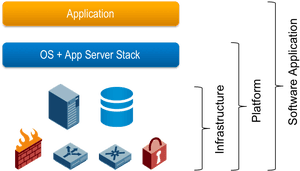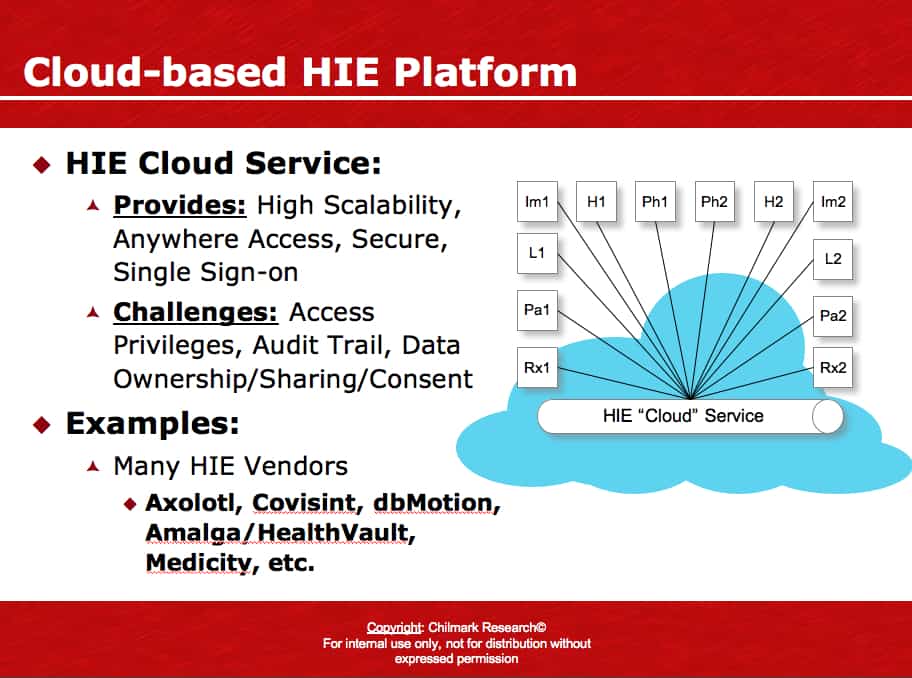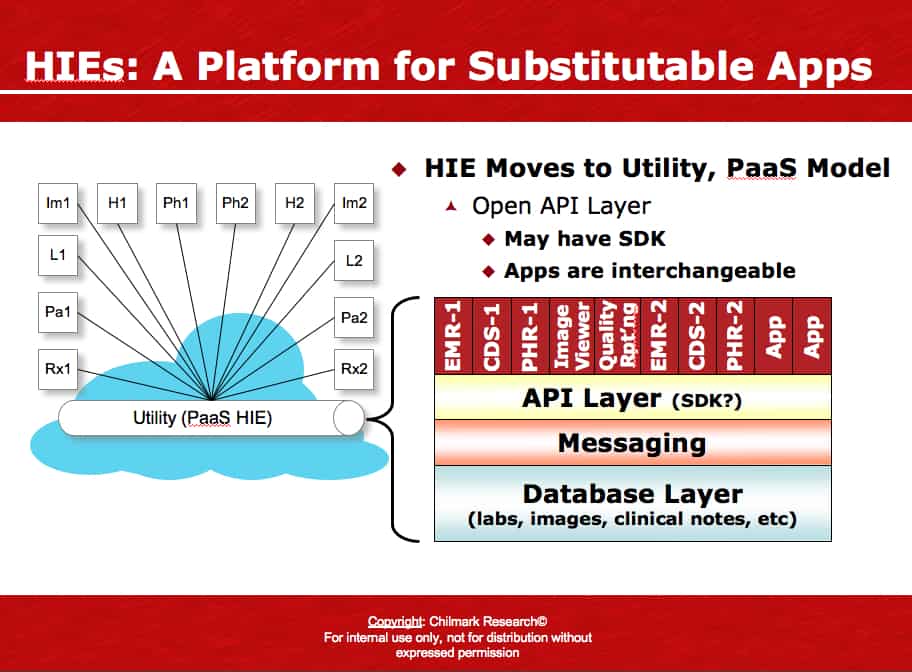
HIE Vendors as Future PaaS for Clinical Needs
Independent HIE vendors (not part of a larger EMR vendor) such as Axolotl, Covisint, dbMotion, InterSystems, Medicity and RelayHealth are in a unique position to become more than just an HIE focusing on the exchange of clinical records but could become Platform as a Service (PaaS) vendors providing a wide range of services and apps on top of their core infrastructure, OS and App Server stack. The following two figures illustrate what is possible should these vendors open up their application programming interface (APIs) to allow other ISVs to build apps on top of their HIE platform.
HIE vendors are in an ideal position to become a PaaS for they already have the key features necessary. As aggregators and distributors of clinical data in a secure fashion, these vendors have the core infrastructure already in place. They have the data repository, they have the master patient index (MPI) and they understand what is required to address privacy and security requirements of data exchange within a network. What these vendors, by and large have not done is open their APIs to third party ISVs to truly create a PaaS.
In speaking with Axolotl’s president Glenn Keet he stated that they came to the realization that they alone could not move fast enough to meet the needs of the market. While they currently offer an CCHIT certified “EMR lite” for small physician practices there are a multitude of other services that they foresee. For example, within the “meaningful use” criteria that physicians will need to demonstrate to receive reimbursement for EHR adoption, there are a number of quality reports that must be created and filed with CMS. Keet envisions ISVs leveraging Axolotl’s APIs to create services to automate such reporting. Meaningful use criteria also will require physicians to sponsor a PHR for their customers. Again, with an open API, PHR ISVs could sit on top of the Axolotl (or other HIE vendor) platform and provide such capabilities. Clinical decision support (CDS) tools are another app/service that would be ideally suited to sitting on top of an HIE PaaS.
Microsoft is another vendor who is now venturing in to the HIE market with its Amalga platform, which is the foundation for the Wisconsin HIE (WHIE). Using its core Amalga UIS along with HealthVault, Microsoft could also create a clinical PaaS with a multitude of ISVs providing services to the physician market. To date and to our knowledge, this has not occurred but we’re pretty sure Microsoft is looking into providing such capabilities as it would be in alignment with other actions that they have done to date in the healthcare sector.
What this may portend is the creation of PaaS that support the concept of substitutable apps as laid out by Ken Mandle and Issac Kohane of Children’s Hospital Informatics Program (CHIP) Boston. Another proponent is David Kibbe with what he refers to as Clinical Groupware a concept he first described back in Febuary 2009. In each of these examples, the dominant theme is the move away from monolithic EMR/EHR apps to small, lightweight apps that are invoked when needed. More information on this concept can be found at the recently created site: ITdotHealth. (Note: Unfortunately, at the recent meeting at Harvard Medical School, Health Information as a Platform, which was organized by Mandl and Kohane, outside of Microsoft, there did not appear to be any representation from HIE vendors.)
An Opportunity for RHIOs to Become Viable?
A lot of effort and money is now being poured into the build-out of public Health Information Exchanges (HIEs) that are commonly referred to as Regional Health Information Organizations (RHIOs). While many see it crucial to build out this information exchange infrastructure to support care coordination (a key criteria for stimulus funding reimbursement for EHR adoption), the challenge for RHIOs has been to create a business plan that insures long-term viability of a RHIO once grant funding drys up. The market is littered with failed, failing and simply struggling RHIOs. Recently, while sitting in on a conference call where a State RHIO discussed their go-live plans a question was asked: Do you have a model for sustaining the RHIO long-term? To which the Executive Director of the RHIO replied, No.
But might not a RHIO that is actually a PaaS for a given region or State, become a provider of Clinical Groupware including a range of services and applications such as multiple lightweight EMRs to choose from, say one for pediatrics, another for orthopedists, a third for general practioners, quality reporting services, a range of CDS apps, etc. charging a small transaction fee for the use of such services and thereby begin to create viable service-based business? We think so and see this as the next evolution in the HIE market.






0 Comments
Trackbacks/Pingbacks